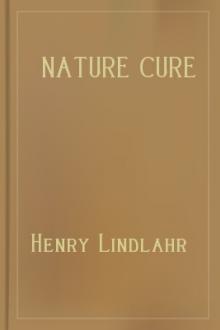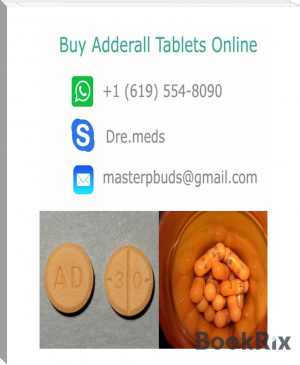Nature Cure, Henry Lindlahr [beautiful books to read .txt] 📗

- Author: Henry Lindlahr
- Performer: -
Book online «Nature Cure, Henry Lindlahr [beautiful books to read .txt] 📗». Author Henry Lindlahr
I would strongly warn against keeping the patient too warm. This is especially dangerous in the case of young children, who cannot use their own judgment or make their wishes known. I have frequently found children in high fever smothered in heavy blankets under the mistaken impression on the part of the attendants that they had to be kept warm and protected against possible draft. In many instances the air under the covers was actually steaming hot. This surely does not tend to reduce the burning fever heat in the body of the patient.
“Natural Diet” in Acute Diseases
From the appearance of the first suspicious symptoms until the fever has abated and there is a hearty, natural hunger, feeding should be reduced to a minimum or better still, entirely suspended.
In cases of extreme weakness, and where the acute and subacute processes are long drawn out and the patient has become greatly emaciated, it is advisable to give such easily digestible foods as white of egg, milk, buttermilk and whole grain bread with butter in combination with raw and stewed fruits and with vegetable salads prepared with lemon juice and olive oil.
The quantity of drinking water should be regulated by the desire of the patient, but he should be warned not to take any more than is necessary to satisfy his thirst. Large amounts of water taken into the system dilute the blood and the other fluids and secretions of the organism to an excessive degree, and this tends to increase the general weakness and lower the patient’s resistance to the disease forces.
Water may be made more palatable and at the same time more effective for purposes of elimination by the addition of the unsweetened juice of acid fruits, such as orange, grapefruit or lemon, about one part of juice to three parts of water. Fresh pineapple juice is very good except in cases of hyperacidity of the stomach. The fresh, unsweetened juice of Concord grapes is also beneficial.
Acid and subacid fruit juices do not contain sufficient carbohydrate or protein materials to unduly excite the digestive processes, while on the other hand they are very rich in Nature’s best medicines, the mineral salts in organic form. Sweet grapes and sweetened grape juice should not be given to patients suffering from acute, febrile diseases because they contain too much sugar, which would have a tendency to start the processes of digestion and assimilation, to cause morbid fermentation and to raise the temperature and accelerate the other disease symptoms.
Fasting
Total abstinence from food during acute febrile conditions is of primary importance. In certain diseases which will be mentioned later on, especially those involving the digestive tract, fasting must be continued for several days after all fever symptoms have disappeared.
There is no greater fallacy than that the patient must be sustained and his strength kept up by plenty of nourishing food and drink or, worse still, by stimulants and tonics. This is altogether wrong in itself, and besides, habit and appetite are often mistaken for hunger.
A common spectacle witnessed at the bedside of the sick is that of well-meaning but misguided relatives and friends forcing food and drink on the patient, often by order of the doctor, when his whole system rebels against it and the nauseated stomach expels the food as soon as taken. Sedatives and tonics are then resorted to in order to force the digestive organs into submission.
Aversion to eating during acute diseases, whether they represent healing crises or disease crises, is perfectly natural, because the entire organism, including the mucous membranes of stomach and intestines, is engaged in the work of elimination, not assimilation. Nausea, slimy and fetid discharges, constipation alternating with diarrhea, etc., indicate that the organs of digestion are throwing off disease matter, and that they are not in a condition to take up and assimilate food.
Ordinarily, the digestive tract acts like a sponge which absorbs the elements of nutrition; but in acute diseases the process is reversed, the sponge is being squeezed and gives off large quantities of morbid matter. The processes of digestion and assimilation are at a standstill. In fact, the entire organism is in a condition of prostration, weakness and inactivity. The vital energies are concentrated on the cleansing and healing processes. Accordingly, there is no demand for food.
This is verified by the fact that a person fasting for a certain period, say, four weeks, during the course of a serious acute illness, will not lose nearly as much in weight as the same person fasting four weeks in days of healthful activity.
It is for the foregoing reasons that nourishment taken during acute disease is not properly digested, assimilated and transmuted into healthy blood and tissues. Instead, it ferments and decays, filling the system with waste matter and noxious gases. interferes seriously with the elimination of morbid matter through stomach and intestines by forcing these organs to take up the work of digestion and assimilation. diverts the vital forces from their combat against the disease conditions and draws upon them to remove the worse than useless food ballast from the organism.
This explains why taking food during feverish diseases is usually followed by a rise in temperature and by aggravation of the other disease symptoms. As long as there are signs of inflammatory, febrile conditions and no appetite, do not be afraid to withhold food entirely, if necessary, for as long as five, six or seven weeks. In my practice I have had several patients who did not take any food, except water to which acid fruit juices had been added, for more than seven weeks, and then made a rapid and complete recovery.
In cases of gastritis, appendicitis, peritonitis, dysentery or typhoid fever, abstinence from food is absolutely imperative. Not even milk should be taken until fever and inflammation have entirely subsided, and then a few days should be allowed for the healing and restoring of the injured tissues. Many of the serious chronic aftereffects of these diseases are due to too early feeding, which does not allow the healing forces of Nature time to rebuild sloughed membranes and injured organs.
After a prolonged fast, great care must be observed when commencing to eat. Very small quantities of light food may safely be taken at intervals of a few hours. A good plan, especially after an attack of typhoid fever or dysentery, is to break the fast by thoroughly masticating one or two tablespoonfuls of popcorn. This gives the digestive tract a good scouring and starts the peristaltic action of the bowels better than any other food.
The popcorn may advantageously be followed in about two hours with a tablespoonful of cooked rice and one or two cooked prunes or a small quantity of some other stewed fruit.
For several days or weeks after a fast, according to the severity of the acute disease or healing crisis, a diet consisting largely of raw fruits, such as oranges, grapefruit, apples, pears, grapes, etc., and juicy vegetables, especially lettuce, celery, cabbage slaw, watercress, young onions, tomatoes or cucumbers should be adhered to. No condiments or dressings should be used with the vegetables except lemon juice and olive oil.
Hydropathic Treatment in Acute Diseases
We claim that in acute diseases hydropathic treatment will accomplish all the benefcial effects which the “Old School” practitioners ascribe to drugs, and that water applications will produce the desired results much more efficiently, and without any harmful by-effects or aftereffects upon the system.
The principal objects to be attained in the treatment of acute inflammatory diseases are:
To relieve the inner congestion and consequent pain in the affected parts. To keep the temperature below the danger point by promoting heat radiation through the skin. To increase the activity of the organs of elimination and thus to facilitate the removal of morbid materials from the system. To increase the positive electromagnetic energies in the organism. To increase the amount of oxygen and ozone in the system and thereby to promote the oxidation and combustion of effete matter.
The above-mentioned objects can be attained most effectually by the simple cold water treatment. Whatever the acute condition may be, whether an ordinary cold or the most serious type of febrile disease, the applications described in detail in the following pages, used singly, combined or alternately according to individual conditions, will always be in order and sufficient to produce the best possible results.
Baths and Ablutions
Cooling sprays or, if the patient is too weak to leave the bed, cold sponge baths or ablutions, repeated whenever the temperature rises, are very effective for keeping the fever below the danger point, for relieving the congestion in the interior of the body and for stimulating the elimination of systemic poisons through the skin.
However, care must be taken not to lower the temperature too much by the excessive coldness or unduly prolonged duration of the application. It is possible to suppress inflammatory processes by means of cold water or ice bags just as easily as with poisonous antiseptics, antifever medicines and surgical operations.
It is sufficient to reduce the temperature to just below the danger point. This will allow the inflammatory processes to run their natural course through the five progressive stages of inflammation and this natural course will then be followed by perfect regeneration of the affected parts.
In our sanitarium we use only water of ordinary temperature as it flows from the faucet, never under any circumstances ice bags or ice water. The application of ice keeps the parts to which it is applied in a chilled condition. The circulation cannot react, and the inflammatory processes are thus most effectually suppressed.
To recapitulate: Never check or suppress a fever by means of cold baths, ablutions, wet packs, etc., but merely lower it below the danger point. For instance, if a certain type of fever has a tendency to rise to 104 degree F. or more, bring it down to about 102 degree. If the fever ordinarily runs at a lower temperature, say at 102 degree F., do not try to reduce it more than one or two degrees.
If the temperature is subnormal, that is, below the normal or regular body temperature, the packs should be applied in such a manner that a warming effect is produced, that is, less wet cloths and more dry covering should be used, and the packs left on the body a longer time before they are renewed. More detailed instruction will be given in subsequent pages.
Never lose sight of the fact that fever is in itself a healing, cleansing process which must not be checked or suppressed.
Hot-Water Applications Are Injurious
Altogether wrong is the application of hot water to seats of inflammation as, for instance, the inflamed appendix or ovaries, sprains, bruises, etc. Almost in every instance where I am called in to attend a case of acute appendicitis or peritonitis, I find hot compresses or hot water bottles, by means of which the inflamed parts are kept continually in an overheated condition. It is in this way that a simple inflammation is nurtured into an abscess and made more serious and dangerous.
The hot compress or hot-water bottle draws the blood away from the inflamed area to the surface temporarily; but unless the hot application is kept up continually, the blood, under the Law of Action and Reaction, will recede from the surface into the interior, and as a result the inner congestion will become as great as or greater than before.
If the hot applications are continued, the applied heat





Comments (0)